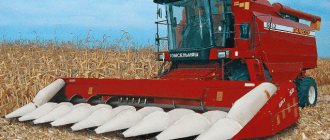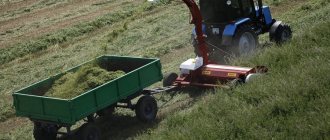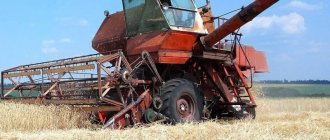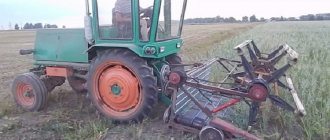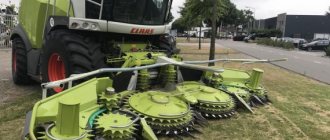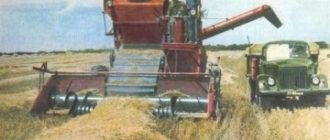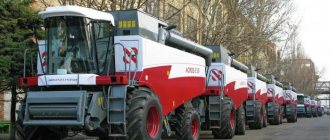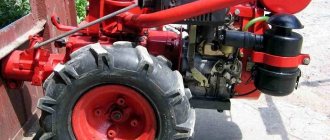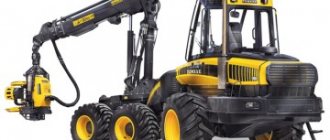Production of the KSK-100 self-propelled combine, intended for harvesting feed, began in 1977. Large-scale assembly of machines was carried out in Gomel until the first half of the 90s.
The plant produced several modifications of the combine:
- Standard model.
- A modernized version, supplied to customers since the mid-80s. It is distinguished by the use of a chassis with improved cross-country ability and a mechanical differential lock.
- Option with increased working area width.
- A combine with a header for harvesting corn and similar crops with strong stems.
About the history of the KSK-100 combine
This combine immediately became a pioneer in a number of ways, and generally a unique machine for its age. In general, the KSK-100 became the first forage harvester in the Soviet Union that was not trailed, but self-propelled. In addition, it was the very first self-propelled agricultural machine in the country with a hydraulically driven chassis. In its design, for the first time in the practice of domestic forage harvesting machinery, replaceable attachment adapters were used.
Serial production of "KSK-100" started in 1977. The main production site for the model was the Belarusian city of Gomel. The launch of this new model was preceded by a total reconstruction and re-equipment of the plant, which increased its production capacity several times at once. Subsequently, serial production of “KSK-100” was also established in the city of Bryansk, at the Bryanskselmash enterprise.
This sought-after machine and its modifications were produced for thirty-two years, until 2009. Mass production and widespread use played a significant role in the development of Soviet crop and livestock production. The 70-80s were a time of significant development of collective and state farms. In particular, the construction of large fattening farms for calves (cattle) in most farms; laying concrete silo pits of significant volume.
Currently, the KSK-100 and its modifications have been replaced by modern Polesie forage harvesters, which are produced not only in Gomel and Bryansk, but also at two large joint ventures in China. These forage harvesters are made according to a modern layout, with a central location of the control cabin. In a technological sense, they also bear little resemblance to the KSK-100 and, naturally, significantly exceed it in productivity and profitability.
Harvester modifications
Significant development and modification of the KSK-100, taking into account the operating experience of these agricultural machines, was carried out at Gomselmash by the mid-80s. The result of this work was the launch in 1985-1986 of mass production of a number of modifications of the combine, with the prefix “A” in the index: “KSK-100A”, “KSK-100A-1”, “KSK-100A-2” and “KSK- 100A-3". In particular, they were distinguished by improved cross-country ability due to the presence of a drive axle with locking.
After all, the main problem identified during the operation of the KSK-100 combines in the first years of production was their insufficient cross-country ability when working on waterlogged and peaty-boggy soils.
In addition, during the modernization process, modifications were created that were designed specifically and purely for harvesting corn and other coarse-stemmed plants, and were equipped with a drum header with a three-meter working width. These are “KSK-100A-B”, “KSK-100A-B-2”, “KSK-100A-B-3”.
Steer axle
To ensure increased cross-country ability and traction capacity, the mower has an axle of steerable drive wheels.
The rotation of wheels 1, 6 (Figure 1.10) of the steering axle is carried out using hydraulic cylinders 3, 7. To synchronize the rotation, a transverse steering rod 8 is used.
1, 6 – wheels; 2 – steering knuckle;
3, 7 hydraulic cylinders; 4 – balancer axis;
5 – bridge beam; 8 – steering rod; 9 rack; 10 hub
Figure 1.10 – Controlled bridge
wheels
Equipment of the combine harvester "KSK-100"
In addition to the drum header, forage harvesters of this brand were equipped with so-called “grass” and “corn” reel-type headers. The “grass” header is used for mowing thin-stemmed crops up to one and a half meters high. The corn header is specially designed for mowing silage crops up to 4 meters high and stems up to 50 millimeters thick.
The brands of harvesters for coarse crops with which the KSK-100 and its modifications are aggregated are as follows: ZhKE-3.0, PKK-0200000A, PKK-0200000, KIL-0800000. Brands of pick-ups for the combine: “PTF-2.2”, “PTF-2.2-01”, “PKK-0350000, KIS-0900000”.
In addition, “UVK-F-1” equipment was installed on the “KSK-100A”, intended for the introduction of liquid organic acids when mowing plants. It consists of a four hundred liter tank, a gas jet ejector, a pump, a dispenser, a sprayer, connecting hoses and a control panel. This device weighs 170 kg.
1.4.2 Mower KS-100. Self-propelled part
The self-propelled part of the mower consists of: chassis 7 (Figure 1.5); engine installation 6; 14 cabins (with air conditioning and heating systems); installation of control platform 13; hydraulic systems 8;
electrical equipment 3; towing device 4; front linkage with quick-connecting devices 12; installation of entrance platform 10; hoods 1; battery installation
2 simulators; wheels 5, 11.
1 – hood; 2 – installation of batteries; 3 – electrical equipment; 4 – towing and coupling
device; 5, 11 – wheels; 6 engine installation; 7 – chassis; 8 – hydraulic system; 9 – installation of fuel equipment; 10 installation of the entrance platform; 12 – front linkage with quick-connecting devices; 13 – installation of the control platform; 14 cabin
Figure 1.5 – Self-propelled part
Operating principle of "KSK-100"
The main components of a forage harvester that ensure its operation are the following components and devices: cutting apparatus; replaceable reel; header auger; front rollers, upper and lower; smooth roller; shear beam; grinding drum; cutter; silo pipeline with guide hood.
Also, modules that increase the speed of passage of processed feed material can be connected to the working elements. They are necessary, for example, at high humidity. Elements are also connected that make it possible to grind cut and collected fodder vegetation from the field to an even finer state.
In a technological sense, the operating principle of the KSK-100 combine is as follows. The reel tilts the plant stems towards the direction of the combine and places them on the cutting device. The cut plant mass is fed by reel rakes to the auger. The auger narrows its flow and directs it to the feeding apparatus.
There, the plant mass is compressed by the upper and lower rollers and travels along the shearbar to the drum, where it is crushed. Cutting the stems occurs when the drum rotates, on which special knives are installed in a spiral. The most efficient cutting is achieved when using shear plates.
After this, the crushed feed mass is sent through a silo pipeline into the body of a vehicle moving on the side of the combine, or a vehicle attached to it from behind. When the KSK-100 forage harvester is equipped with a replaceable chopping apparatus with a chuck, the mass crushed by the drum falls into the shredder and is quickly sent through the silo line to the vehicle. At the same time, the design of the silo line allows the transport to receive silage to be located both on the left and on the right of the combine.
High-quality harvesting: review of forage harvesters
In the current economic conditions, supplies of feed and feed additives have decreased slightly, while their costs have begun to increase significantly. In such a situation, it is important for agricultural producers to increase their own production of feed, especially haylage and silage. For their high-quality harvesting in the largest volume, reliable harvesting equipment is required.
Now the state provides support for the purchase of specialized agricultural machines. Of course, the conditions and opportunities for agricultural producers are different, however, when deciding to purchase units on credit or leasing, it is more advisable to pay attention to modern machines for harvesting corn, sunflowers, seeded cereals and leguminous forage grasses up to 1.5 m high. New equipment must be energy efficient, reliable and passable, have low operating costs, allow you to harvest various crops of varying degrees of maturity and humidity, while ensuring excellent grinding, the addition of preservatives and high quality feed preparation. For these reasons, it is necessary that any forage harvester be equipped with a good chopper, a system for introducing special preparations and a device for sharpening knives. Don't skimp on built-in stone and metal detectors as they ensure feed safety and increase the life of the feed rollers. It is advisable that the detectors be connected to the grinder's emergency stop system.
Technical characteristics of the combine harvester "KSK-100"
The KSK-100 forage harvester has rear-wheel drive. The transmission is based on a three-speed gearbox, which allows reverse movement and braking using a hydraulic drive.
Engines "KSK-100"
Forage harvesters "KSK-100" and modifications in different years of production were equipped with domestic diesel engines of three types: "SMD-72" (Kharkov and Belgorod), "MMZ D-260.4" (Minsk) and "YaMZ-238AM-2/3" (Yaroslavl). The power of these power units for KSK-100 combines is in the range of 200-220 horsepower. Specific diesel fuel consumption ranges from 221 to 228 g/kWh (162-168 g/hp/h)
Engine "MMZ D-260.4".
Transmission of the combine harvester "KSK-100"
The transmission consists of a three-speed gearbox, hydraulic drive of the chassis, V-belt drive and a set of gearboxes for driving attachments. The combine can move in reverse.
Technical characteristics of "KSK-100" in numbers
- Overall dimensions, excluding equipment and adapters: length –5,720 meters; width – 3,180 meters; height – 3,550 meters.
- The total weight of the combine is from 11,050 to 11,450 tons, depending on the modification.
- Recommended maximum speed: in operation – 12 km/h; during transportation – 20 km/h.
- Harvesting capacity: green grass – 10 kg per second; dried grass – 7 kg/s; corn, sunflower, etc. silage crops – 25 kg/s.
- Width of the headers: “grass” – 4.2 meters; “corn” - 3.4 meters; “drum” – 3 meters.
- The pick-up width is 2.2 meters.
- Minimum cutting height: grass – 60 mm; corn and other silage crops – 80 mm.
- Cutting length – 5; 10; 15; 20; 25 mm (with 12 knives).
- Additional cutting length – 30; 40; 50; 60; 75mm.
- Dimensions of the drum grinding apparatus: width – 64.8 cm; diameter – 75 cm.
- The height of loading the crushed mass into vehicles is 3.5 meters.
Mower KS-100. Motor installation
The mower is equipped with a diesel engine with a performance assurance system.
The engine is mounted on shock absorbers and mounted on the mower frame. The radiator block is mounted on shock-absorbing plates.
The radiator block includes radiators for coolant, oil and charge air. The oil cooler consists of sections connected in parallel: Sections for cooling the oil in the hydraulic system of the drive of the adapters and the feeding apparatus, sections for cooling the oil in the hydraulic system of the chassis drive.
Air intake 5 (Figure 1.6) cleans the air from plant debris and dust.
Oil is refilled into the engine through the filler neck.
2. Used oil is drained from the engine crankcase through drain hole 6, closed with a plug.
1 – installation of an air purifier; 2 filler neck; 3 installation of a muffler; 4 engine; 5 air intake; 6 drain hole
Figure 1.6 – Engine installation
The engine air supply system is designed to supply dust-free air to the cylinders. The air is pre-cleaned in a pre-cleaner of the rotating air intake type (Figure 1.7), which is installed on the inlet pipe of the air cleaner and secured with a tension clamp.
To clean the air supplied to the cylinders, a dry type air cleaner is installed using paper filter cartridges as a filter element. The air cleaner is secured with clamps under the hood cover.
To monitor the clogging of filter cartridges, a warning lamp on the control panel is used, which lights up when an electrical sensor installed on the engine air manifold pipe is activated.
Reliable and economical operation of the engine is ensured only when the air supply system is completely sealed.
Technical characteristics and operating rules are given in the operating documentation for the engine supplied with each mower.
1 – mesh; 2 – cover; 3 – bolt; 4 – oiler; 5 bearing; 6 – impeller
Figure 1.7 – Rotating air intake
Cabin of the combine harvester "KSK-100"
The combine cabin is a separate design module and can be replaced entirely. It provides excellent visibility in all directions and is equipped with large rear-view mirrors.
Naturally, in Soviet times there was no question of a comfortable stay for the operator in the cab: the atmosphere was very spartan. However, in the KSK-100 combines of later years of production, the cabin is already equipped with such means of increasing work comfort as an adjustable steering wheel and operator’s seat.
Reviews from owners of KSK-100 combines
The main advantages that almost all owners of this classic forage harvester talk about are its high performance and extreme endurance, reliable and durable engines, absolute simplicity of design and control, and the highest maintainability.
Combine harvesters "KSK-100" are very easy to operate and do not require serious operator training. "KSK-100" provide very high-quality harvesting of forage plants (with minimal losses not exceeding 1%); demonstrate low specific costs per unit of silage mass.
The most frequent repairs are required for shafts and drums, since these devices are not protected against the ingress of foreign objects. Rear-wheel drive does not have the best effect on cross-country ability in waterlogged and swampy areas. The front wheels periodically begin to get stuck in wet soil. This problem can be solved by installing arched tires, which significantly reduce the specific pressure on the soil.
According to reviews from owners, the operation of KSK-100 combines has the following features. An increase in movement speed leads to an increase in the processed plant mass, and leads to the production of silage from larger trimmings. And to minimize the size of individual particles of silage feed mass, the speed of movement of the KSK-100 combine should be reduced to minimum values, which are determined experimentally by the machine operator.
Since the ingress of foreign objects often leads to breakage of the drum knives or accelerated failure, their number is sometimes reduced by half (from twelve to six). Working with dried grass requires installing an exhaust fan behind the drum to increase the efficiency of extracting chopped feed.
The use of a special drum header for harvesting corn ensures harvesting of stalks without limiting their height, while the loss of corn cobs is practically eliminated; increasing the degree of grinding of stems and cobs; reducing noise levels, increasing reliability; reducing the labor intensity of maintenance; the lowest specific costs per unit of harvested mass.
The fact that KSK-100 combines are still in demand on the market is due to their relatively low cost, excellent maintainability, and good ability to adjust operating settings.
All this allows the KSK-100 combine to be used profitably for harvesting both large fields of large agricultural companies and small private farms. In both cases, the practical value of using the KSK-100 combine is high.
Benefits and reviews
KSK 100 has advantages that make it popular. These include:
- Easy to operate, eliminating the need for lengthy training of the driver-operator.
- Possibility of carrying out repairs on your own and in the field.
- High harvest rate.
- The ability to use it as an independent unit that collects, stores and transports crops.
Many reviews indicate that after several decades the combine remains the most popular when carrying out harvesting work. Along with the listed advantages and positive qualities, there are several minor disadvantages :
- the drum may break due to foreign objects getting into it;
- low level of permeability on wet soil;
- the need to install additional equipment at high humidity.
Price of the combine harvester "KSK-100"
As already noted, the KSK-100 forage harvesters and all their varieties have been discontinued since 2009 in both Gomel and Bryansk. Until recently, the cost of the new KSK-100 combine harvester of the latest modification ranged from one and a half to two million rubles, depending on the configuration. Now there are no completely new “KSK-100” left on the agricultural machinery market.
But the secondary market offers a large number of “KSK-100” in very different technical conditions. Prices are also varied. A used KSK-100 combine, in good condition and running, can now be purchased for 100 thousand rubles. If, of course, you have considerable experience in operating and repairing this agricultural machinery. A used “KSK-100” in fairly good technical condition can be bought for 500 thousand rubles.
Engine
In the basic version, the KSK 600 Polesie is equipped with a 4-stroke diesel engine YaMZ 238AK-1 (Yaroslavl Motor Plant) with direct fuel injection, liquid cooling and a mechanical speed controller. The unit operates stably at peak loads, providing high throughput under all operating conditions. The latest versions received a turbocharging system. The engine is based on the design of the YaMZ 238M2 engine.
Characteristics of the YaMZ 238AK-1 unit:
- working volume – 14.86 l;
- rated power – 173 (235) kW (hp);
- rotation speed – 2000 rpm;
- maximum torque – 932 Nm;
- number of cylinders – 8;
- cylinder diameter – 130 mm;
- specific fuel consumption – 220 (162) g/kW per hour (g/hp per hour).
The engine service life before the first major overhaul is 5000 hours. The fuel tank capacity is 400 liters.
Optionally, a foreign Mercedes-Benz OM 906 LA engine is installed on the KSK 600 Polesie combine harvester.
